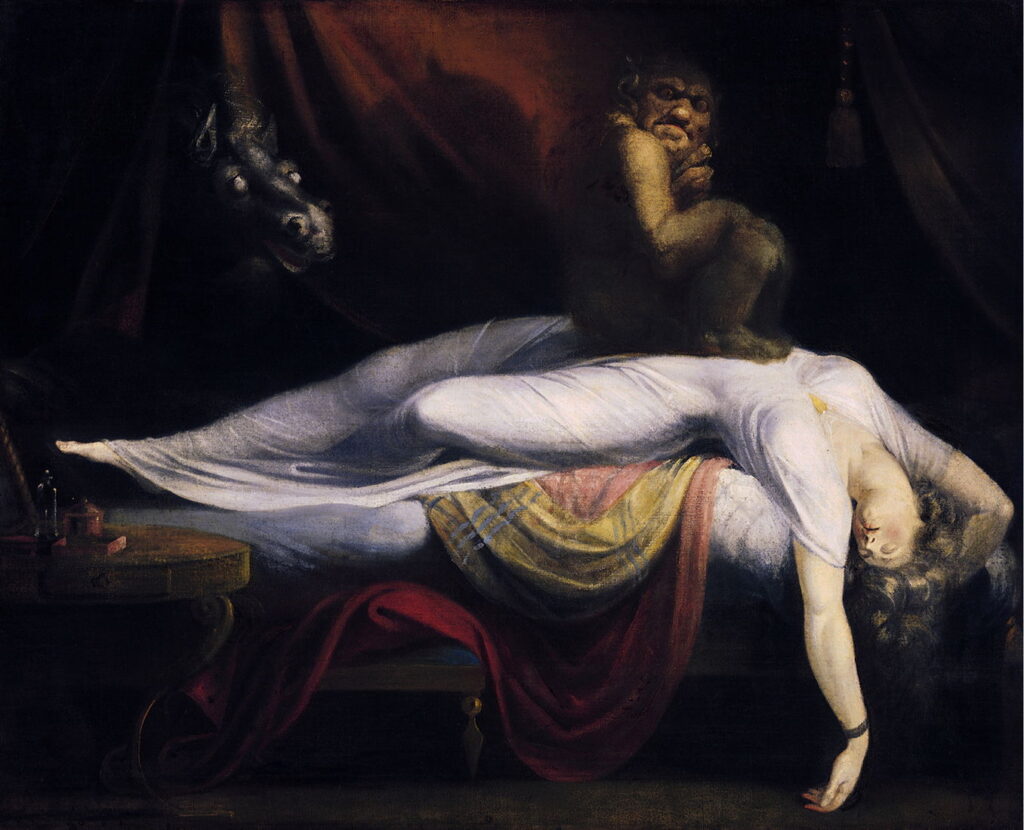Commemorating the bicentenary of Henry Fuseli’s death: 1

Two hundred years ago, on either 16 or 17 April 1825, the Swiss artist Henry Fuseli died in his adopted country Britain, where he had been one of the leading narrative painters, and an important figure in the Royal Academy. In this article and tomorrow’s sequel, I outline his career with the support of a small selection of his paintings. The uncertainty over the date of his death results from a conflict with Wikipedia, which claims it was a day later than the Royal Academy does.
He was born in 1741 as Johann Heinrich Füssli in Zürich, Switzerland, to a large artistic family. Expecting to train to paint, he was surprised when his father sent him instead to start theological training, with the intention of him becoming a priest. He took up orders in 1761, but fled Switzerland shortly afterwards because of his involvement in exposing an unjust magistrate. He travelled through Germany, and in 1765 arrived in England.
At first, he made a precarious living in England by writing and translating. He seized the chance to show Sir Joshua Reynolds his drawings, and was advised to devote himself to painting. To further this goal, as he had received little formal training at this stage, he went to Italy in 1770, where he studied painting, and changed his last name to Fuseli.
On his return to England in 1779 he found his reputation already building, and was commissioned to paint for Boydell’s new Shakespeare Gallery, a bold scheme to develop an English school of history painting, based largely on income generated from prints.
Henry Fuseli (1741–1825), Thetis Lamenting the Death of Achilles (1780), tempera on cardboard, 41.8 × 55.8 cm, The Art Institute of Chicago, Chicago, IL. Wikimedia Commons.
His Thetis Lamenting the Death of Achilles from 1780 isn’t easy to read. In the foreground, Achilles’ body lies like a fallen statue on his shield, his great spear by his left side. There’s no sign of any wound, arrow, or injury. At the water’s edge, his mother Thetis is waving her arms in lament for her dead son. Another deity is flying past in the distance, and is seen white against the dark and funereal sea and sky.
Henry Fuseli (1741-1825), The Two Murderers of the Duke of Clarence (1780-82), oil on canvas, 68.6 x 53.3 cm, Folger Shakespeare Library, Washington, DC. Wikimedia Commons.
He painted The Two Murderers of the Duke of Clarence in 1780-82, probably for Boydell’s gallery. It shows a scene from William Shakespeare’s historical play Richard III, where the King has sent this pair to kill Clarence in the Tower of London.
Henry Fuseli (1741–1825), Tiresias Appears to Ulysses During the Sacrifice (1780-85), watercolor and tempera on cardboard, 91.4 × 62.8 cm, Albertina, Vienna, Austria. Wikimedia Commons.
Fuseli became a prolific painter of literary narrative. His Tiresias Appears to Ulysses During the Sacrifice from 1780-85 is perhaps the only painting that shows Odysseus summoning the ghost of the blind seer Tiresias, after he had spent a year with Circe. In Book 11 of Homer’s Odyssey, Odysseus was instructed to consult Tiresias about his means of returning home to Ithaca, and does so using a process known as nekyia, with the sacrifice of a ram and a ewe as shown here.
Fuseli’s transformative year was 1781, when he painted no less than three masterpieces.
Henry Fuseli (1741–1825), Dido (1781), oil on canvas, 244.3 x 183.4 cm, Yale Center for British Art, New Haven, CT. Wikimedia Commons.
Dido has here mounted her funeral pyre, and is on the couch on which she and Aeneas had earlier made love. She then fell on the sword that Aeneas had given her, and that rests, covered with her blood, beside her, its tip pointing up towards her right breast. Her sister Anna rushes in to embrace her during her dying moments, and Jupiter sends Iris (wielding a golden sickle) to release Dido’s spirit from her body. Already smoke seems to be rising from the pyre, confirming to Aeneas that she has killed herself, as he heads towards the horizon, and the eventual founding of Rome.
Henry Fuseli (1741–1825), The Nightmare (1781), oil on canvas, 101.6 × 127 cm, Detroit Institute of Arts, Detroit, MI. Wikimedia Commons.
The Nightmare was exhibited at the Royal Academy in 1782, and remains the work by which Fuseli is best known today. It shows a daemonic incubus squatting on the torso of a young woman, who is laid out as if in a deep sleep in bed, her head thrown back, and her arms above her head. Lurking in the darkness to the left is the head of a black horse, whose eyes appear unseeing. The incubus stares directly at the viewer in a manner that arouses discomfort. Fuseli also painted a second version with a slightly different composition, which is as well-known.
Henry Fuseli (1741–1825), The Dream of Queen Katharine (Shakespeare, Henry VIII, Act IV, Scene 2) (1781), oil on canvas, dimensions not known, Victoria and Albert Museum (Bequeathed by Rev. Chauncey Hare Townshend), London. Image courtesy of and © Victoria and Albert Museum, London.
Dream of Queen Katherine, above, is a remarkable fragment of a larger painting intended to show this scene from Shakespeare’s Henry VIII, and was commissioned by Thomas Macklin in 1779 for his Poets’ Gallery. It’s most likely to have been cut down from a copy of a painting similar to The Vision of Catherine of Aragon, below, which was commissioned by Sir Robert Smith and exhibited at the Royal Academy in 1781.
Henry Fuseli (1741–1825), The Vision of Catherine of Aragon (1781), oil on canvas, 147.3 x 210.8 cm, Lytham St Annes Art Collection, Lytham St Annes, Lancashire, England. Wikimedia Commons.
Queen Katherine of Aragon, wife of King Henry VIII of England, is on her deathbed. After her attendant has told her about the death of Cardinal Wolsey, the queen falls asleep and has a remarkable dream, for which Fletcher’s stage directions read:
The vision. Enter, solemnly tripping one after another, six personages, clad in white robes, wearing on their heads garlands of bays, and golden vizards on their faces; branches of bays or palm in their hands. They first congee unto her, then dance; and, at certain changes, the first two hold a spare garland over her head; at which the other four make reverent curtsies; then the two that held the garland deliver the same to the other next two, who observe the same order in their changes, and holding the garland over her head: which done, they deliver the same garland to the last two, who likewise observe the same order: at which, as it were by inspiration, she makes in her sleep signs of rejoicing, and holdeth up her hands to heaven: and so in their dancing vanish, carrying the garland with them. The music continues.
Henry Fuseli (1741–1825), King John, Act III, scene 1 (1783), further details not known. Wikimedia Commons.
Fuseli’s painting from another play by Shakespeare, King John, Act III, scene 1 (1783), shows the young Arthur with his mother distraught at the compromise for peace, which dropped his claim to the throne.
Henry Fuseli (1741–1825), Percival Delivering Belisane from the Enchantment of Urma (1783), oil on canvas, 99.1 x 125.7 cm, The Tate Gallery (Presented by the Art Fund 1941), London. © The Tate Gallery and Photographic Rights © Tate (2016), CC-BY-NC-ND 3.0 (Unported), http://www.tate.org.uk/art/artworks/fuseli-percival-delivering-belisane-from-the-enchantment-of-urma-n05304
His painting of Percival Delivering Belisane from the Enchantment of Urma (1783) shows a narrative that the artist had invented for this painting. It appears to be one of a series, although only one other work has been identified as part of that, and that precursor is only known from a print of 1782. He also preceded this series with a single painting of Ezzelin and Meduna (1779), referring to another unique narrative, but doesn’t appear to have any associated works.
Fuseli provides the viewer with a rich array of ‘Gothic’ narrative elements to form their own account of the story. There are visions of faces in the distance on the left, chains leading to an unseen figure apparently manacled into a bed at the right, Percival swinging a sword above his head, to strike the cloaked figure of Urma in the left foreground, and a beautiful young woman (presumably Belisane) embraced by Percival’s left arm, kneeling on the floor.
Henry Fuseli (1741–1825), The Shepherd’s Dream (1786), black chalk, brush, ink and brown ink, sanguine, white chalk and wash over pencil on paper, dimensions not known, Albertina, Vienna, Austria. Wikimedia Commons.
The Shepherd’s Dream from 1786 is an elaborate drawing made in preparation for the oil painting below. As it shows many of the elements within Fuseli’s composition more clearly than the painting, it is probably more useful for understanding their narrative.
John Milton’s (1608-1674) Paradise Lost held a special appeal for Fuseli since he had been introduced to it when a student. These works show a scene in the poem when the fallen angels in the Hall of Pandemonium (in Hell) are compared to the fairies who bewitch a peasant with their music and dancing:
… fairy elves,
Whose midnight revels by a forest side
Or fountain some belated peasant sees,
Or dreams he sees, while over head the moon
Sits arbitress, and nearer to the earth
Wheels her pale course, they on their mirth and dance
Intent, with jocund music charm his ear;
At once with joy and fear his heart rebounds.
Fuseli transforms the convention of these fairies dancing on the ground, and instead they swirl through the air above the sleeping shepherd. One of the fairies is touching the shepherd with his wand, to keep him asleep. At the lower left, a fairy has pulled a mandrake root, which has transformed into a tiny homunculus, and is now standing. At the far right, sat on the steps, is the small figure of Queen Mabs (or Mab), responsible for bringing nightmares.
Henry Fuseli (1741–1825), The Battle Between Thor and the Snake of Midgard (1788), oil on canvas, 131 × 91 cm, Royal Academy of Arts, London. Wikimedia Commons.
The Battle Between Thor and the Snake of Midgard (1788) shows one of Thor’s many exploits: his battle with the monstrous Jörmungandr, a sea serpent born of the giant Angrboða and Loki. This celebrated battle occurred when Thor went fishing with the giant Hymir. Thor baited a strong line with an ox head, which the serpent bit. When Thor pulled it from the water, Hymir shied away, as shown here. When Thor reached for his hammer to kill Jörmungandr, Hymir cut the line, letting the serpent escape, only to face a further battle with Thor at Ragnarök, the end of the world.
I believe this was the painting that Fuseli presented as his diploma work when he was elected a full academician in the Royal Academy in 1790.
Henry Fuseli (1741–1825), Prince Arthur and the Fairy Queen (c 1788), oil on canvas, 102.5 × 109 cm, Kunstmuseum Basel, Basel, Switzerland. Wikimedia Commons.
His painting of Prince Arthur and the Fairy Queen from about 1788 crosses into Arthurian legend in showing Arthur, son of Uther Pendragon, here the bearer of a magic shield that blinds his enemies and turns them to stone.



